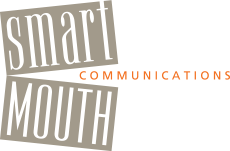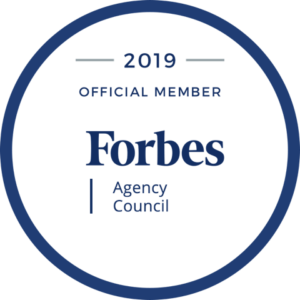SmartMouth Talks!
Short and Crisp
 There’s a lot of good advice out there about public speaking. Much of it is geared toward aiding the speaker. I want to throw some advice into the mix that’s helpful to the speaker and the audience: Keep your sentences short and crisp!
There’s a lot of good advice out there about public speaking. Much of it is geared toward aiding the speaker. I want to throw some advice into the mix that’s helpful to the speaker and the audience: Keep your sentences short and crisp!Speakers do best when they prepare a talk in bullet points rather than prose.
Preparing by writing a long beautiful document is problematic for a couple of reasons. For starters, speakers tend to get attached to the beautiful words, phrases and sentences they’ve composed. This is dangerous! It means the speaker is likely to feel compelled to read at the podium – which is bad for obvious reasons – or to memorize, which runs the risk of producing robotic delivery. Being conversational and staying connected with your audience, even if your delivery is imperfect, are still preferred.
On the other side of the podium, audiences need pace and rhythm and patter.
For audiences, long, fancy sentences become a maze for the ears, something to get lost in. Preparing by writing a long, lovely piece of prose produces something that readers, not listeners, would be willing and able to digest. Listeners need things to keep moving along at a clip. They need the speaker to start and finish a thought quickly in order to hang in there and actually get it.
Move from script to bullet points.
You can always begin your preparation for a presentation by writing out a full-text script. It can help you establish order, organization and some of your key phrases. But then you would be wise to use that script only as a practice tool. As soon as you can, switch over to bullet points and then rehearse your talk from those.
Finally, when it’s showtime, watch yourself … keep a lid on those long-winded run-on, multi-clause sentences. Set a standard and a pace for yourself that requires you to make your sentences short, crisp, distinct units.
Good luck, your audiences will thank you!
Moving the Needle
 Hey everyone, I need to ask a favor!
Hey everyone, I need to ask a favor!If you are lucky enough to be offered training or a professional development opportunity by your organization, can you please 1) accept, and 2) go with the mindset that you want to move the needle and grow, rather than attend just to check the box and say you went?
Awesome, thanks!
Putting some of your own skin in the game – that is, committing to yourself that you will try and learn something new, try and take something away that you will employ – can make all the difference. And that would be all the difference to YOU! Your employer hopefully benefits too, but it’s really all about you. Your time is precious, so if you’re being asked to spend a chunk of it learning something, be sure to make it worth your while and mine the session for the valuable nuggets that will enhance your performance and up your game. That’s your responsibility to yourself.
Then there’s the session leader’s responsibility to you. Clearly, it’s one thing for you to sit and hear about new ideas or best practices, and it’s yet an entirely different thing to try and employ them. If you attend a training or work with a coach, it’s the trainer’s or coach’s job to ensure that you leave with some skill-building practice already under your belt, or at the very least some actionable tips and follow-on activities that will help reinforce the learning. It doesn’t always happen that way, but it should, so feel free to ask for it.
So why am I raising this issue? Well, this is the exact issue that keeps me up at night. It’s my mission as a trainer and coach to not just deliver the workshop or coaching session but to ensure that the recipients get something they feel confident they can and will try to use or do differently. The best sessions are constructed with multiple opportunities for participants to test-drive the learning and with follow-on activities that are designed to keep the concepts and best practices on participants’ radar screens for as long as possible. By definition, training and coaching are intended to encourage change (for the better), and in order to achieve change (arguably, one of the most difficult challenges out there!), there needs to be repetition, reminders, and reinforcement.
To that specific end, SmartMouth Communications will now be offering its SmartMouth OnDemand “Presentations” course to reinforce our presentation skills trainings. While “Presentations” is also a great stand-alone training tool, it will no doubt serve as the ultimate reinforcement tool for anyone who attends a training of ours.
If you or your organization wants to be able to deliver more influential and impactful presentations, give us a shout! We’d love to bundle a live training with an e-learning experience to maximize the benefit for you!
Other People’s Words
 How good are you at delivering the party line?
How good are you at delivering the party line?Most organizations create the party line in the form of talking points. Talking points might be about the organization generally or about a specific piece of news. They typically are handed down from the top for “messengers” to deliver. These messengers, whether they are managers communicating to an internal audience or spokespeople facing an external audience, are expected to deliver the party line. It’s an age-old practice – but with varying results.
The intention behind talking points is solid, which is to help an organization present a unified front, deliver a consistent message, and be sure that everyone is singing from the same song book, so to speak. However, talking points are more often than not other people’s words. And other people’s words can be problematic – hence, the varying results.
The problem with other people’s words is that it’s just not realistic to expect people to deliver them the way they were written. Some real-life challenges with talking points are as follows (see if any of these sound familiar!):
- They are often long, wordy documents – even when they’re broken up into bullet points or paragraphs – that are written more for a reader to read than for a speaker to speak. This makes them difficult for people to digest and actually use.
- Most spokespeople aren’t sure what they’re supposed to do with talking points – memorize or paraphrase? And there’s typically no guidance provided.
- Pre-scripted talking points often feel stilted or inauthentic to the person who is supposed to deliver them. They are other people’s words, and so the messengers read them and think, “but this doesn’t sound like me, I would never say this.”
- In the end, a lot of people who are supposed to be messengers or spokespeople simply avoid and then ignore talking points – which, of course, defeats the original purpose of trying to get everyone on the same page.
So, what can be done to help protect and promote the party line?
Well, if you’re responsible for creating and distributing talking points, here are some tips:
- Give guidance to your troops, let them know how closely to the script they need to stay and what they can and cannot paraphrase.
- Give them permission to use their own words – with the caveat that, if there are some critical words or phrases within the talking points, those are “must-air” words.
- Be realistic and keep the talking points document as brief and succinct as possible.
If you have to deliver talking points, here are some tips for you:
- Go through the document a few times and then put it away and practice making as many of the points as you can. Test yourself to see how well you at least covered the spirit of the talking points, if not the words.
- Highlight the words and phrases that mean the most to you and that you do not want to leave out, and then rehearse yourself through a version that hits on those.
- Ask, if it hasn’t been granted already, for permission to paraphrase, making the case that you will do a better – more authentic and credible – job of delivering the party line if you can hit the points you’re most passionate about in a way that works for you.
A little effort – and a little give – from both sides will be worth it, good luck!
What Do You Do When the Audience is Glaring at You?
 And are they really glaring or are they just staring?
And are they really glaring or are they just staring?
Ugh! Does that mean you’re tanking? Not connecting or getting through to your audience? Should you keep going with your presentation or is it time to switch gears? You can’t run out of the room, or fall through a hole in the floor, you have to make the best of it. But how?
Stay calm. Keep things in perspective. And, if you feel like it’s more than a few faces – and that they’re really not happy – then open up a dialogue (e.g. Q&A) and find out if you’re right or not.
Audience reactions come in all forms, shapes and sizes. We hope for the best-case scenario – to look out at the audience and see excited, expectant and engaged faces. But we don’t always get that. Very often, we get stone faces or we get that guy in the front row who looks angry, that woman in the middle row on the end who looks like she’s falling asleep, or the other woman in the back looking at her phone.
Whatever you see, don’t panic and don’t judge yourself – or them – too harshly. Keep things in perspective. Especially when the audience is full of strangers, bear in mind that you have no context for interpreting their facial expressions or behaviors. It’s important to remember that one man’s scowl is another man’s look of concentration. And that some people remember and retain better with their eyes closed. And that other people take notes on their phones or other devices.
They are distracting as all get-out, but one or two dissatisfied-looking people in an audience do not make for a failed presentation. There are always a few people in a group who don’t like something, are not quite as enthusiastic or just had the wrong expectation, no question. But there are others who just look unhappy or disinterested. Keep going, keep up your energy level and try to engage audience members as much as possible.
If, however, you are so distracted by the faces that you are beginning to believe that you are, in fact, tanking, then switch gears and open up your presentation for some discussion and dialogue. Ask your audience for their impressions, thoughts, and questions up to that point. That way, you’ll know for sure whether they’re satisfied or not, and engaged with you or not.
The moral of the story is that you shouldn’t let the demeanor and appearance of the crowd, especially one person in the front row, affect your performance. It’s sometimes hard to tell an angry glare from a focused stare.
Let Us Calm Your Nerves
Some Comforting Facts About Public Speaking
 Do you want learn how to overcome public speaking anxiety? Do you feel like your body is fighting against you every time you get behind the podium? Does it seem like the audience can see how nervous you are?
Do you want learn how to overcome public speaking anxiety? Do you feel like your body is fighting against you every time you get behind the podium? Does it seem like the audience can see how nervous you are?
Well you aren’t alone! Three out of four people suffer from speech anxiety. It is the most prevalent and commonly shared phobia.
In fact, Jerry Seinfeld once joked that most people are more afraid of public speaking than they are of death. He said, “This means if you have to go to a funeral, you’re better off in the casket than delivering the eulogy.”
There’s even a term for fear of public speaking; it’s glossophobia. Literally translated from Greek, it means fear of the tongue. Clearly, stage fright has been around forever. I get asked about nervousness all the time. It’s real, most people experience it, and I take it seriously.
But I’m also a pragmatist about it. I feel like I’ve heard it all—nerves that cause shaking, forgetfulness, dry mouth, speed-talking, sweating, you name it. But I’ve never seen anyone
die like they think they’re going to. And I’ve rarely, if ever, seen an audience that noticed the speaker was nervous. You, as the speaker, are obviously fully in tune with your anxiety, but the audience isn’t looking for it.
In fact, I’ve held mock presentation sessions for groups and had people sit down after it was their turn speaking and say, “Oh my gosh, I couldn’t breathe up there” … yet no one else in the group noticed. This is what you need to know: Audiences expect you to be just fine, and so that’s what they see—a speaker or presenter who is just fine.
They actually expect you to succeed! They’re unlikely to notice the shaking or other physical manifestations of nerves, and they have no way of knowing that you accidentally skipped a whole section of your talk. Remember, you’ve got a home-court advantage, so to speak. The audience assumes you’re going to be great!
Deep Dive
 You’ve created something really amazing. Everyone wants to know more. The story of your success, how you got there, and what’s next draw curiosity-seekers and other interested parties like flies to flypaper.
You’ve created something really amazing. Everyone wants to know more. The story of your success, how you got there, and what’s next draw curiosity-seekers and other interested parties like flies to flypaper.
So, what do you tell them? What’s your narrative? Do you have your usual spiel all dialed in? Is it something that rolls off your tongue without you having to think about it too much? Perhaps most important, though, is it strictly about your work or does it include you, the person?
Take a second to think about this.
The usual company narrative – dare I say, the “fallback” – is the one you might have generated for the VC community or for Wall Street, or it’s the one your marketing people crafted for selling your products and services. Or maybe it’s a combination of those two. If so, it’s probably great, but it’s not enough going forward. It’s actually not inspiring enough.
Audiences and your stakeholders crave a more earthy, gritty, revealing and more personal articulation of the journey – your success, how you got there, and what’s next. They want to feel it, feel a part of it, and they want to be inspired. By you. They want to be drawn in, engaged, connected. By you, the leader.
This matter is top of mind for me. I recently have had several requests from Marketing, Communications, and Brand Managers who have come to me requesting public speaking help for their CEO’s. Their concerns have ranged from the leader being “awesome but dry and uninspiring” to reports of being “brilliant but unable to connect.” Ouch!
Despite these less than stellar reviews, my experience in coaching executives and entrepreneurs tells me that it’s there, it’s in them. It’s usually pretty close to the surface, it just needs to be coaxed or allowed to come out. It may even need to be teased out by a trusted friend or advisor. But it’s right there.
So, what am I suggesting here? How do you go about creating a more personally inspiring narrative? Where do you begin?
Take a deep dive. Tap into yourself, your deepest self. Prepare to open up and share your vulnerability as well as your passion – for example, what makes you doubt yourself and what makes you tick, what scares you and what excites you.
Here are some questions to prompt your thinking:
What was my worst fear when I started this job/venture?
What was my worst moment?
Where did I most go right/wrong?
Where did I overshoot/undershoot?
What was my biggest surprise?
What do I love to do every day?
What do I love most about this project/company?
What have we forgotten/underemphasized?
How have the people I work with impacted me personally/professionally?
How has this venture exceeded my expectations?
What is my greatest wish for this project/company?
The answers to these questions will provide you with sound bites you can use to open with, weave into your existing presentation, or even formulate an entire talk. Think about using these sound bites as being transparent, but on steroids: being as open with your thoughts and feelings as you are with information.
There’s also a lot of chatter about the effectiveness of storytelling, both the wisdom and the science behind connecting with audiences by using stories. Everyone loves a good story, because they love to be entertained – even, or especially, during an informative or persuasive presentation. Your dreams, nightmares, successes and failures all make great story material; sharing them would make audiences feel very much a part of your journey.
There’s a lot to be gained – and nothing to be lost – by using your story, your narrative, and engaging your audiences and stakeholders on a deeper level. Make a note of the reactions and comments you get from people after you do. I’m willing to bet it will result in greater buy-in and engagement – from employees, investors, customers, and even vendors and partners.
Impromptu?
“It usually takes me more than three weeks to prepare a good impromptu speech.” – Mark Twain
 Always a colorful character, Mark Twain got right at the heart of public speaking with wit and humor. He’s right, there is almost never such a thing as a good impromptu speech. Almost every speech you hear that you find enjoyable or compelling is the result of preparation.
Always a colorful character, Mark Twain got right at the heart of public speaking with wit and humor. He’s right, there is almost never such a thing as a good impromptu speech. Almost every speech you hear that you find enjoyable or compelling is the result of preparation.
But Mark Twain’s comment highlights more than the benefits of preparation, it highlights the fact that audiences are drawn in by a speech that feels impromptu. They prefer a speaker who is more conversational than mechanical, and yet there is a delicate balance being prepared and sounding scripted or mechanical.
However, true to nature, Mark Twain might have exaggerated a little bit. You don’t need to prepare for more than three weeks. The kind of preparation I’m suggesting can take as little time as a minute, but, of course, if you can give it longer, that’s even better!
Being prepared is just about the most audience-centric thing you can do. It confers a sense of importance and value on your listeners. It shows respect for their time and is arguably the least you can do in exchange for their attentiveness to you as a speaker. Plus, it ensures that what you deliver is actually received. Preparation shows—as does a lack of preparation.
All too often, though, people resist preparing for a talk. Clients have told me it feels egotistical or self-important to them, and they feel—or want to appear—more humble than that. In their minds, preparing a “speech”—whether that means welcoming remarks at an event, a thank-you for an award, or even an introduction for a speaker—feels bloated and unnecessary. Still, a speaker has a responsibility to deliver something of value to their audience, and the best way to do that is to be prepared.
When a speaker or presenter is prepared, the audience notices. The speaker is on point, and the message is clear and relevant to the audience. The prepared speaker doesn’t open with, “Well, I didn’t have time to prepare anything, so I hope you’ll bear with me.” Instead, the prepared speaker opens with an anecdote or an attention-grabbing factoid specific to that particular audience. Or the prepared speaker knows his or her goal for the talk and puts it out there right up front.
There are many who speak or present in front of groups often enough that they feel it’s okay—and in fact, for some it feels more comfortable—to just “wing it.” Wingers are gamblers. Sometimes they win, but other times they lose. Since the outcome can go either way, you have to ask yourself if you can afford a loss. Or can you afford even to risk it? If speech prep were short enough and simple enough, would you devote just a few seconds to being prepared? I think anyone would.
So here are a few simple preparation tips that not only reduce your risk but actually connect you more quickly and directly with your audience:
Develop mini stump speeches. If you know there are projects or issues that you typically need to address, take a few minutes and develop some ready message points. These should be short, crisp statements that convey value or importance, focusing on the “why” and not the “what.” If you have these in your back pocket and you’re called on to speak, you’re halfway there. Add a story or anecdote that illustrates your message, and you’re good to go.
Be selective with information. Whatever you do, don’t fall into the trap of thinking if you just do a lot of research, present a lot of data, or share a lot of detail, that you’re prepared to address an audience. Preparation requires you to think about the significance of your talk—the “why,” not the “what”—and to be prepared to convey that before you get to any supporting information.
Disrupt Chronology. If you have only a few seconds or minutes to prepare, think about what your summary or conclusion would be for your talk—and then deliver that as your whole talk. If you feel the need to elaborate a bit more, at the very least use your summary as your opening. Disrupting chronology means serving dessert – or the audience’s takeaway – first, while their attention spans and ability to retain are highest.
[Excerpted in part from Jock Talk: 5 Communication Principles for Leaders as Exemplified by Legends of the Sports World, www.jocktalkbook.com]
On Your Own Time, At Your Own Pace
 In the introduction of my book Jock Talk last year, I noted that the business world was suffering from a bad (and performance-inhibiting) case of communication neglect. This year, SmartMouth is offering a cure that can help on the large-scale organizational level or the individual level, but before we dive into that, let’s harken back to my book:
In the introduction of my book Jock Talk last year, I noted that the business world was suffering from a bad (and performance-inhibiting) case of communication neglect. This year, SmartMouth is offering a cure that can help on the large-scale organizational level or the individual level, but before we dive into that, let’s harken back to my book:
“Tolerance of mediocrity in business communication is my pet peeve. It’s not only the mediocrity itself that bothers me, it’s also the acceptance of it and the lack of action taken to remedy it. There are simply too few people calling phooey, or if they are calling phooey, they don’t know how to change things for the better—how to raise the bar.
“I believe you can start with this: Make medal-worthy communication skills a core value. Then get to work on making them a core competency. Organizations hire me to work one-on-one with executives or to train executive teams. Often they come to me with a wish list like this: They’re so long-winded, can you make them more succinct? Can you add some polish and professionalism? They need to make a better impression. Is there any way you can make them sound more commanding? I can, and I usually do. Most of the time what they have been delivering, and how they have been delivering it, has been adequate—not particularly bad, not particularly good, simply adequate. It met the low standard that business audiences have come to expect.
“Well, what is standard in the business world may be adequate, but it’s not optimal and, let’s face it, it shouldn’t be acceptable. Think about how often you roll your eyes during meetings that are too long and, worse, pointless. Think about the boring presentations you’ve sat through—the ones in which you waited for the single valuable nugget, that one answer, that lone call to action that came at minute 52 out of an hour-long talk. Think about the speech by the CEO who was incredibly dry or who mouthed the same old-same old. A bar set at adequate or standard is far too low for organizations that expect excellent outcomes—or aim to be the best in the world.”
Under our traditional model, SmartMouth coached individuals and trained groups out of this rut – in person. But we realized that, as much as we were driven to be evangelists for change in conference rooms and boardrooms everywhere, we couldn’t reach everyone in person.
That’s why we developed SmartMouth OnDemand. Our online communication training lets us offer our insights, strategies and proprietary methodology to anyone who has an Internet connection and a device.
Presentations is our first – and our flagship – course. It is full of games and interactive segments that are only slightly modified from what we do in our in-person group sessions. Best of all, Presentations is loaded with our SpeechBuilder tool – a fill-in-the-blanks form that prompts you to outline your remarks for any occasion – and anyone who takes the course gets lifetime access to the tool. Pretty soon, we will be adding courses that dive in even deeper on topics like Visuals, Delivery and Storytelling.
Online communication training is the future of the industry. Its flexibility, low cost to the user, and effectiveness make it the obvious choice for organizations that want to enact large-scale change in how employees communicate and for individuals with busy schedules and tight budgets.
Pointers!
 I know better, but I’m as guilty as the next person when it comes to placing too much emphasis on content – the actual words and phrases – when preparing for a presentation. Communicating, as you might know anecdotally, is as much about your body language and facial expressions as it is about your words.
I know better, but I’m as guilty as the next person when it comes to placing too much emphasis on content – the actual words and phrases – when preparing for a presentation. Communicating, as you might know anecdotally, is as much about your body language and facial expressions as it is about your words.
Here are some interesting facts about the importance of non-verbal communication:
- Human communication is 20% verbal and 80% non-verbal. This means if you’re saying something but your body language says the opposite, you’re not likely to get your message across.
- According to researchers, our bodies express emotion better than our faces.
- The average person actually only speaks words for a total of 10-11 minutes a day. And the average sentence takes 2.5 seconds to say.
- We make and recognize about 25,000 facial expressions a day.
- Pointing is one of the most offensive gestures pretty much around the globe.
- Hand-steepling is the most high-confidence hand gesture. This involves touching the spread fingertips of both hands in a gesture similar to praying hands, but the fingers are not interlocked and the palms may not be touching.
- Power poses – e.g. standing up, sitting with arms spread out on the on the chairs around you, “Wonder Woman” stance (feet planted; hands on hips) – make speakers feel more powerful as they actually change testosterone and cortisol levels in the body.
Be body-aware and body-smart. Think about your face, your body and your posture. Identify what your “job” is – your communications task for each public speaking occasion – and practice what that might look and sound like as part of your preparation. In other words, what does persuasion look and sound like; what does reassurance look and sound like; what does motivation look and sound like? Practice with your words, but also make sure it looks and sounds like you!
The Basics
 Use visualization and positive imagery …
Use visualization and positive imagery …Do breathing exercises …
Tell a joke …
Picture your audience in their underwear …
Should you try these techniques? Will they put you at ease? Most important, will they help you engage your audience?
There’s a lot of multi-tasking required of a speaker while delivering a presentation:
- opening properly
- getting the amplification of the microphone or natural projection of the voice just right
- advancing slides or juggling A/V equipment
- making eye contact and employing good body language
- managing time, and
- remembering the flow of the presentation material
Honestly? The last thing a speaker needs is distracting gimmicks on top of the multi-tasking. I prefer the basics: simply focus on connecting with the audience.
In fact, the SmartMouth approach is based first and foremost on the concept of audience-centricity. Or, as I like to say, “It’s not all about you, it’s about them!” Getting back to basics in presentation training means reminding speakers to focus squarely on their audiences from preparation all the way through to the end of delivery.
What does this mean in practical terms? Well, here’s a short checklist to help you understand what I mean:
- When preparing a speech or presentation, think about what interest the audience might have in your topic and what aspect or angle would be most beneficial to them – rather than what interests you.
- Go to the front of the room worrying about giving your audience a good experience – rather than worrying about how you look or whether you sound smart. (You do look good, you made sure of that already! And you are smart, that’s why you’re at the front of the room!)
- Open by acknowledging your audience – offering a compliment, recognizing good work, identifying a common bond – before you introduce yourself or share anything about your background.
- Look at them as if you were trying to draw them in and make new friends. Even move toward them if you can slip away from the podium. Make the people in front of you a more important focus – than yourself and your material.
- Remember to smile, be present, use people’s names if you can, and be yourself. People really like all of those things. It puts them at ease and engages them. And when they’re at ease and engaged, you will be too!



